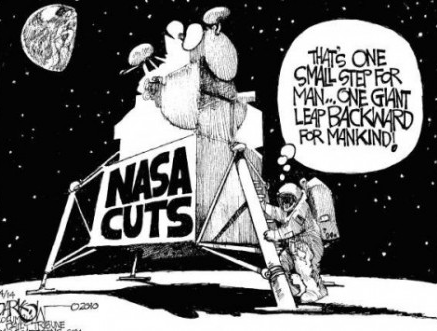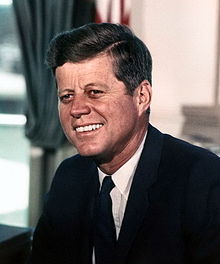Political Effects

Permission to use this image from: John Darko
- Big Budgets associated with Space Exploration are hard for the political parties to swallow without sufficient public sentiment.
- Reduced Federal Budgets mean that NASA presently has no usable manned spacecraft.
- Fear of Russia's space exploration inspired the Government to get ahead in the space race.
Space Race
NASA was essentially formed in response to the "Space Race". Both the US and USSR were worried about either gaining a technological upper hand in rocket technology that would give them superior weapons. The Space Race was triggered during the Cold War, when Soviet Russia developed the first InterContinental Ballistic Missile (ICBM). The theory was that whoever could get into space first would have a huge advantage over the enemy. In 1957, Russia launched Sputnik I, their first artificial orbital satellite and US politicians were forced to "do something" so they could keep up or catch up with the Russians. By the year 1961, the U.S. used the space race as a reason for going to the moon and as a way to increase their national prestige in the eyes of the world.

While the entire world watched, as the Soviets circled the earth President John F. Kennedy (in 1961) would announce his plan to place a man on the moon before the Soviets. Americans joined in their support for the space race to the moon. Interest in the Space programs decreased due to the country's concerns with the Vietnam War. As a result Conservatives took over the Space program and tried to force Shuttle designs for military payloads. Civilian usage was dismissed and the GOP refused to fund the research to build the type of Shuttle that was needed. Lack of funding plus little political commitment decreased the effectiveness of NASA and the two were disconnected for a few years.
During the Lyndon Baines Johnson administration (1963-1968) a treaty was signed called the "Treaty on Principles Governing the Activities of States in the Exploration and Use of Outer Space, including the Moon and Other Celestial Bodies". The 1967 Outer Space Treaty was signed by the USA and Soviets and sixty-four other countries. This would put an end to the competition to claim celestial bodies.
Statement by President Nixon, 5 January 1972
I have decided today that the United States should proceed at once with the development of an entirely new type of space transportation system designed to help transform the space frontier of the 1970's into familiar territory, easily accessible for human endeavor in the 1980's and '90's.
Returning To The Moon
It was 1972 when man last set foot on the surface of the moon. There was no direct money made from the moon program. The technologies developed during the space program from 1970 thru 2000 has led to advances in, satellite weather systems, Global Positioning Satellites and other areas. The money that the government has made from these technologies alone significantly outweighs the costs of the space program. NASA believes that they would expect the same sort of return on investment this time around. Unfortunately it appears that the funding for exploration of the moon has been cut off by congress and the President. Returning to the moon will be the responsibility of the private sector.

Jupiter's moon Ganymede, is larger than the planet Mercury!